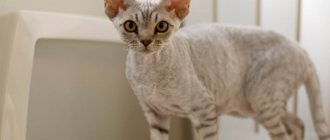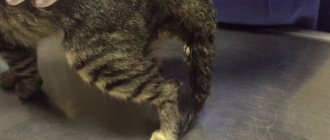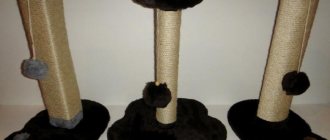By bringing a small fluffy kitten into our home, we take responsibility for its health. In addition to proper feeding, vaccinations, and grooming, ear cleaning should become a regular procedure. This is necessary in order to prevent ear diseases, which cause suffering in pets and take a long time to treat. Questions about how to clean a kitten’s ears, whether it is necessary to do this if the ear is clean, arise often. It all depends on the pet’s lifestyle, the breed, and even the size of the ears.
Feasibility of the procedure
The kitten cannot clean its ears on its own, so it needs help. Dirty ears cause the development of an inflammatory process, so you need to systematically monitor the condition of the ears and take all necessary measures in a timely manner.
When cleaning is necessary
The procedure should be carried out once every 2-4 months. The frequency depends on the breed of the pet. For example, the ear shell of sphinxes gets dirty much faster. It should be cleaned 1-2 times a week .
A similar situation is observed among Rexes, Abyssinians, and Siamese. They undergo hygiene measures weekly.
The procedure is carried out in the following cases:
- dusty deposits, dirt;
- brown, black dots, spots;
- dry crusts of dark color;
- discharge of pus;
- excess sulfur;
- dried blood, scratching;
- unpleasant odor;
- the pet shakes its head, scratches the area behind the ears.
Inspection of the ears is carried out daily, and cleaning as they become dirty.
The most common ear problems
In addition to ear mites, pets often encounter other diseases that require treatment, and if left untreated, lead to serious complications.
Otitis
Otitis is a disease in which the ear canal is affected by bacteria or yeast.
It is characterized by the following symptoms:
- purulent discharge with an unpleasant odor can be observed from the ears;
- the cat shakes its head intensely;
- the mucous membranes of the ears turn red and swell;
- The pet constantly scratches itself and meows.
Therapy is prescribed by a veterinarian after examination. Self-medication can cause complications and lead to inflammation or deafness.
Hematomas
Formed due to ruptures of blood vessels.
Reasons: The cat often shakes its head or scratches its ears. They can be identified by small burgundy spots between the auricle and the skin.
Solar dermatitis
Albinos, hairless cats and pets with white ears are susceptible to this disease. Solar dermatitis can be identified by redness of the skin and hair loss at the edges.
If you don't take action, the itching may cause your cat or cat to scratch its ears and cause an infection. There is a risk of tumors.
Squamous cell carcinoma
This neoplasm is a consequence of solar dermatitis. It affects various areas of the skin, but most often develops on cat ears. The main symptoms include red spots, lumps and hair loss. There may be ulcers that do not heal for a long time.
Frostbite
Due to hypothermia, there is a risk that the ear tissue will collapse. It can be identified by changes in skin color, first it loses color and then turns red. At the last stage it turns black and begins to peel off.
Restless behavior is caused by otitis media, ear mites, fleas or allergies. Only an established cause will help solve the problem.
To make an accurate diagnosis and correctly prescribed treatment, it is necessary to consult a specialist.
Features of the procedure
There is an opinion that cotton swabs should not be used. This method is traumatic, so it is recommended to resort to an alternative option: you can also clean the ear from dirt and secretions with water, but you need to wash the baby carefully so as not to scare it.
Safety regulations
Before performing the procedure, you should learn how to properly clean your pet’s ears from dirt.
The following manipulations are performed:
- The animal is wrapped in a towel.
- The ear is carefully bent outward, and the curves of the inner part become clearly visible.
- A cotton pad is moistened in a special product.
- Carefully wipe the inside.
- If necessary, such actions are repeated, but with a clean disk.
- Moisten the cotton swab. Clean the bends from the inside to the outside, otherwise the dirt may push deeper, and this can lead to inflammation.
Owners are often afraid that the animal's eardrum may be damaged when performing such actions. But you shouldn’t be afraid of this: kittens have a bend in the ear canal that does not allow deeper cleaning of the ear.
There is a risk of damage to delicate skin, but this happens if hard sticks are used or the actions are performed carelessly.
When dirt in the ears is an indicator of disease
Sometimes dirty ears are an indicator of a disease. Contacting a veterinary clinic may be required if:
- ears get dirty within a few days after hygiene procedures;
- a lot of wax is produced in the ear canal;
- purulent discharge does not stop;
- At the same time, the cat is restless, itches often, leaving scratches, and shakes its head.
Such symptoms occur with otitis media of any severity or when the ear canal is damaged by ear mites. Accurate diagnosis is carried out in a veterinary clinic. The earlier treatment is started, the more effective it is, and the less the animal suffers.
If left untreated, your pet may experience deafness. In addition, the ear contains the vestibular apparatus, which is responsible for balance. If your cat has ear diseases, he or she may experience dizziness and nausea.
Drops are used to treat ear diseases. In some cases, the veterinarian may prescribe antibacterial and anti-inflammatory drugs.
It is necessary to instill the medicine only after removing purulent discharge and sulfur, otherwise the effect of the drug will not be effective. The cleansing procedure is carried out in the same way as for healthy cats, but instead of a special cleansing gel, the doctor may recommend hydrogen peroxide or chlorhexidine. After recovery, they should not be used. They cause the delicate skin on the inside of the ears to dry out and peel. For the same reason, you should not use products containing alcohol.
Necessary materials
To properly clean your pet’s ears at home, you must first stock up on all the necessary materials.
You will need:
- cotton swab or swabs;
- baby wipes (you can use a cotton pad instead);
- towel;
- nylon muzzle (needed for an aggressive animal).
Deeply soiled cleaning
You can clean deep dirt as follows:
- The kitten is fixed in a comfortable position.
- A special product is instilled into the ear.
- The ear is gently massaged in the lower part - this way the drug is distributed evenly throughout the entire inner part.
- The animal is released so that the pet can shake its head.
- The kitten is picked up again, the cotton swab is immersed deeper, removing dirt
- Additionally, cleaning is carried out using a cotton pad.
- Similar manipulations are performed with the second ear.
Overview of allowed funds
Read the instructions carefully: the product should be intended specifically for cleaning, and should not contain anti-inflammatory components.
It is allowed to use drugs for dogs.
For these purposes the following are assigned:
- Doctor Vic. Lotion made in Belarus. Used to soften sulfur before cleaning or treatment.
- EAR cleaner. The drug is produced in the United States of America. It contains aloe and lanolin. The components help eliminate itching and relieve irritation.
- Leopard. Domestic product. The lotion is an alcohol solution of dimethyl sulfoxide with glycerin.
- Aurocline. The drug is made in Italy. Contains chamomile extract. Helps soften sulfur.
If it is impossible to purchase special products, you can use saline solution and heated olive oil.
Washing is unacceptable:
- chlorhexidine;
- alcohol-containing preparations;
- soap solutions;
- hydrogen peroxide.
Uses of hydrogen peroxide
The use of hydrogen peroxide is strictly prohibited . The product causes the skin in the ear canal to dry out. The formation of ulcerations and cracks is noted. Such changes lead to deterioration.
Cleaning your cat's ears at home
Not only people, but also cats should have clean ears. Does this mean that you need to clean your cat’s ears regularly? Not at all!
Most cats cope well with this task on their own, with the only exceptions being some purely artificial breeds, such as Sphynxes and Scottish Folds. We will look at cleaning the pink ears of these girlfriends and their friends below. For now, let's talk about the erect ears of furry pets.
This is what good, healthy cat ears should look like:
Translucent, without bald spots on the outside, without spots or foreign inclusions on the inside, the guard hair covering the outside of the ear is clean and even.
Aesthetically revealing ears! Unhealthy ears look different. This ear should alert the owner:
If the sparse guard hair covering the ear performs its function - not to allow debris from the outside to enter, then the wax produced inside the ear does its own.
Rules for cleaning ticks
Ear mites live in the ear canal and feed on skin cells. It is impossible to see the parasite with the naked eye. Only the products of its vital activity are clearly visible (dirty dark brown flakes).
The symptoms of the lesion are as follows:
- restless behavior;
- the pet shakes its head, scratches its ear, scratches it until it bleeds;
- rubs his head against interior items;
- an unpleasant odor appears;
- the presence of dark crusts is noted;
- hearing problems arise.
Such changes cannot be ignored. Special means are used. The drug Bars is considered the most affordable.
The ear is treated as follows:
- The pet is wrapped in a towel and placed on your lap. He should be stroked and calmed down.
- The auricle is turned out. The kitten is securely restrained.
- Wipe the inner surface with a moistened cotton swab.
- Use a cotton swab to go along the curves, without bringing it into the ear canal.
After removing the plaque, they begin to get rid of the mites: take a cotton swab, moisten it in the product and gently wipe the ear canal (the swab is not inserted too deeply).
These actions are performed daily for 2 weeks. The medicine is instilled into the ear every 4 times. It is important that the kitten does not shake its head, otherwise the drug will spill out.
Ear examination
In order to detect and treat ear disease in a timely manner, examinations are carried out weekly.
A healthy cat's ears are clean, warm, and slightly oily to the touch. If the animal is released from home, inspection is carried out daily. A cat can get ticks, and sometimes its ears are injured during a fight. The ingress of foreign objects cannot be completely excluded.
The inspection is simple. It is necessary to bend the sink and inspect the inner surface. To better see nooks and crannies, you can use a flashlight.
Security measures
To minimize the risk of damage, it is recommended that the procedure be carried out by two people: one person will hold the kitten, and the second will perform the hygiene procedure.
Before doing this, it would be a good idea to trim the animal’s claws or use special anti-scratch guards.
Before starting the main actions, prepare all the equipment. The pet is wrapped in a towel and calmed down.











